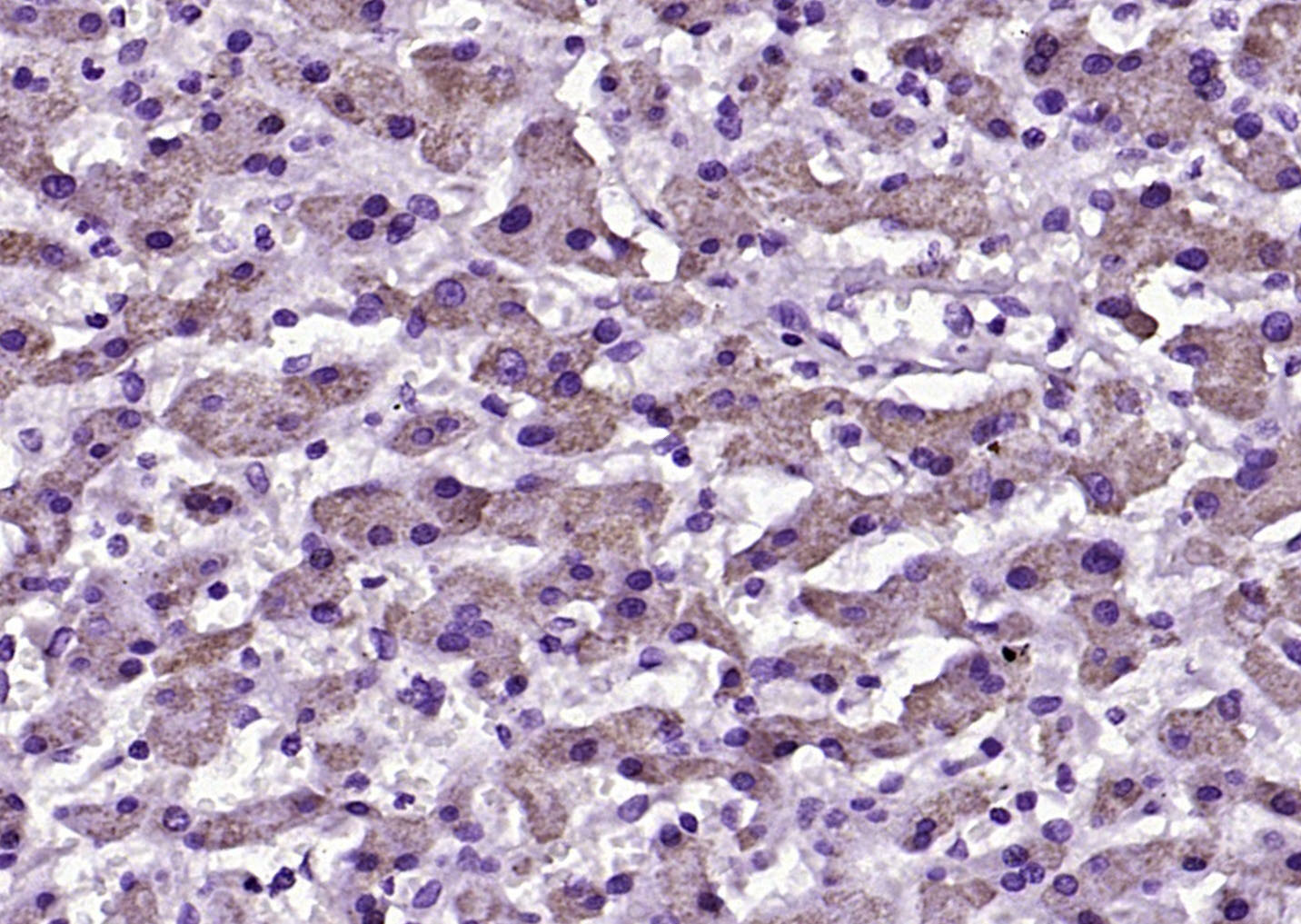ANGPTL8 Rabbit pAb
ANGPTL8 Rabbit pAb
- 产品详情
- 实验流程
- 背景知识
Application
| IHC-P, IHC-F, IF |
|---|---|
| Primary Accession | Q6UXH0 |
| Reactivity | Human |
| Host | Rabbit |
| Clonality | Polyclonal |
| Calculated MW | 22105 Da |
| Physical State | Liquid |
| Immunogen | KLH conjugated synthetic peptide derived from human C19orf80 |
| Epitope Specificity | 31-198/198 |
| Isotype | IgG |
| Purity | affinity purified by Protein A |
| Buffer | 0.01M TBS (pH7.4) with 1% BSA, 0.02% Proclin300 and 50% Glycerol. |
| SUBCELLULAR LOCATION | Secreted. |
| SIMILARITY | Belongs to the ANGPTL8 family. |
| SUBUNIT | Interacts with ANGPTL3. |
| Post-translational modifications | Proteolytically cleaved at the N-terminus. |
| DISEASE | Diabetes mellitus, insulin-dependent (IDDM) [MIM:222100]: A multifactorial disorder of glucose homeostasis that is characterized by susceptibility to ketoacidosis in the absence of insulin therapy. Clinical features are polydipsia, polyphagia and polyuria which result from hyperglycemia-induced osmotic dieresis and secondary thirst. These derangements result in long-term complications that affect the eyes, kidneys, nerves, and blood vessels. {ECO:0000305|PubMed:24078058}. Note=The gene represented in this entry may be involved in disease pathogenesis. Increased protein levels are observed in the serum of patients. This result should however be reinvestigated in light of recent advances that suggest that this protein is not promoting pancreatic beta cell proliferation. Diabetes mellitus, non-insulin-dependent (NIDDM) [MIM:125853]: A multifactorial disorder of glucose homeostasis caused by a lack of sensitivity to the body's own insulin. Affected individuals usually have an obese body habitus and manifestations of a metabolic syndrome characterized by diabetes, insulin resistance, hypertension and hypertriglyceridemia. The disease results in long-term complications that affect the eyes, kidneys, nerves, and blood vessels. {ECO:0000305|PubMed:24852694, ECO:0000305|PubMed:24963292, ECO:0000305|PubMed:25024395, ECO:0000305|PubMed:25303484}. Note=The gene represented in this entry may be involved in disease pathogenesis. Increased protein levels are observed in the serum of patients and are associated with insulin resistance (PubMed:25024395, PubMed:25303484, PubMed:24963292, PubMed:24852694). According to another report, protein levels are decreased in the serum of patients (PubMed:25050901). Discrepancies between increased and decreased levels of proteins levels in NIDDM patients may be explained by the use of different kits developed on the market that either use antibodies recognizing the N-terminal or the C-terminal part of the protein (PubMed:25099942). These results should however be reinvestigated in light of recent advances that suggest that this protein is not promoting pancreatic beta cell proliferation. |
| Important Note | This product as supplied is intended for research use only, not for use in human, therapeutic or diagnostic applications. |
| Background Descriptions | ANGPTL8 (Angiopoietin Like 8) is a Protein Coding gene. Diseases associated with ANGPTL8 include Breast Angiosarcoma and Breast Sarcoma. Among its related pathways are Lipoprotein metabolism and Metabolism. |
| Gene ID | 55908 |
|---|---|
| Other Names | Angiopoietin-like protein 8 {ECO:0000312|HGNC:HGNC:24933}, Betatrophin, Lipasin, Refeeding-induced fat and liver protein, ANGPTL8 (HGNC:24933) |
| Target/Specificity | Predominantly expressed in liver. Also expressed in adipose tissues. |
| Dilution | IHC-P=1:100-500,IHC-F=1:100-500,IF=1:100-500 |
| Storage | Store at -20 °C for one year. Avoid repeated freeze/thaw cycles. When reconstituted in sterile pH 7.4 0.01M PBS or diluent of antibody the antibody is stable for at least two weeks at 2-4 °C. |
| Name | ANGPTL8 (HGNC:24933) |
|---|---|
| Function | Hormone that acts as a blood lipid regulator by regulating serum triglyceride levels (PubMed:22569073, PubMed:22809513, PubMed:23150577). May be involved in the metabolic transition between fasting and refeeding: required to direct fatty acids to adipose tissue for storage in the fed state (By similarity). |
| Cellular Location | Secreted. |
| Tissue Location | Predominantly expressed in liver. Also expressed in adipose tissues. |
Research Areas
For Research Use Only. Not For Use In Diagnostic Procedures.
Application Protocols
Provided below are standard protocols that you may find useful for product applications.
BACKGROUND
ANGPTL8 (Angiopoietin Like 8) is a Protein Coding gene. Diseases associated with ANGPTL8 include Breast Angiosarcoma and Breast Sarcoma. Among its related pathways are Lipoprotein metabolism and Metabolism.
终于等到您。ABCEPTA(百远生物)抗体产品。
点击下方“我要评价 ”按钮提交您的反馈信息,您的反馈和评价是我们最宝贵的财富之一,
我们将在1-3个工作日内处理您的反馈信息。
如有疑问,联系:0512-88856768 tech-china@abcepta.com.
¥ 1,500.00
Cat# AP55296























 癌症的基本特征包括细胞增殖、血管生成、迁移、凋亡逃避机制和细胞永生等。找到癌症发生过程中这些通路的关键标记物和对应的抗体用于检测至关重要。
癌症的基本特征包括细胞增殖、血管生成、迁移、凋亡逃避机制和细胞永生等。找到癌症发生过程中这些通路的关键标记物和对应的抗体用于检测至关重要。 为您推荐一个泛素化位点预测神器——泛素化分析工具,可以为您的蛋白的泛素化位点作出预测和评分。
为您推荐一个泛素化位点预测神器——泛素化分析工具,可以为您的蛋白的泛素化位点作出预测和评分。 细胞自噬受体图形绘图工具为你的蛋白的细胞受体结合位点作出预测和评分,识别结合到自噬通路中的蛋白是非常重要的,便于让我们理解自噬在正常生理、病理过程中的作用,如发育、细胞分化、神经退化性疾病、压力条件下、感染和癌症。
细胞自噬受体图形绘图工具为你的蛋白的细胞受体结合位点作出预测和评分,识别结合到自噬通路中的蛋白是非常重要的,便于让我们理解自噬在正常生理、病理过程中的作用,如发育、细胞分化、神经退化性疾病、压力条件下、感染和癌症。






